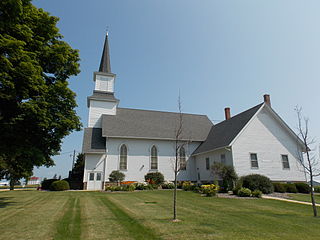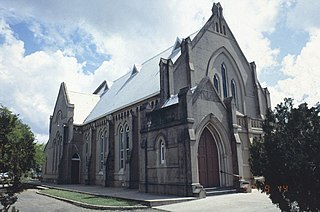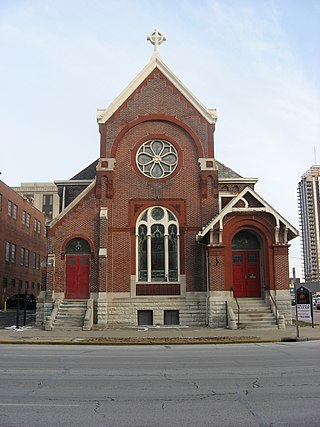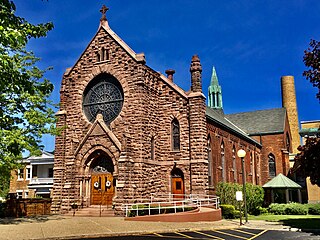
All Saints Anglican Church is a heritage-listed church at 32 Wickham Terrace, Spring Hill, City of Brisbane, Queensland, Australia. First founded in 1862, the current building designed by Benjamin Backhouse was completed in 1869, making it the oldest Anglican church in Brisbane. For most of its history, it has been identified with the High Church or Anglo-Catholic tradition within Anglicanism. It was added to the Queensland Heritage Register on 21 October 1992.

St. Paul's (Zion's) Evangelical Lutheran Church is the official name of what is usually referred to as St. Paul's Lutheran Church in Red Hook, New York, United States. Its six buildings and cemetery are on a 15-acre (6.1 ha) lot on South Broadway just south of the village center. The current church is the third building on a spot that has been home to what was originally a Reformed congregation since 1796.

St. Thomas' Episcopal Church is located on Leedsville Road in Amenia Union, New York, United States. It is a mid-19th century brick church designed by Richard Upjohn in the Gothic Revival architectural style, built for a congregation organized shortly before.

Saints Peter and Paul Catholic Church is a former parish church of the Diocese of Davenport. The church is located in rural Solon, Iowa, United States. The property is on a gravel road east of Iowa Highway 1 between Solon and Mount Vernon in rural Johnson County. It was listed on the National Register of Historic Places in 1999.

The Saint Michael and All Angels Episcopal Church is a historic church located in rural Cambridge Township in northwestern Lenawee County, Michigan. The church was designated as a Michigan Historic Site on October 2, 1980. On February 4, 2004, the church, along with the adjacent Cambridge Township Cemetery, was added to the National Register of Historic Places.

St. Mary's Catholic Church is a parish church of the Diocese of Davenport. The church is located at the corner of St. Mary's and Washburn Streets in the town of Riverside, Iowa, United States. The entire parish complex forms an historic district listed on the National Register of Historic Places as St. Mary's Parish Church Buildings. The designation includes the church building, rectory, the former church, and former school building. The former convent, which was included in the historical designation, is no longer in existence.

St Andrew's Uniting Church is a heritage-listed Uniting church at 131 Creek Street, Brisbane CBD, City of Brisbane, Queensland, Australia. It was designed by George David Payne and built in 1905 by Alexander Lind & Son. Initially St Andrew's Presbyterian Church, it became part of the Uniting Church following the merger of the Presbyterian, Methodist and Congregational Churches in 1977. It was added to the Queensland Heritage Register on 21 October 1992.

Old East Paint Creek Lutheran Church is located north of Waterville, Iowa, United States. The church building was listed on the National Register of Historic Places in 1983.

Saint John's Lutheran Church is an active church building located at 121 South Locust Street in the city of Adrian in Lenawee County, Michigan. It was designated as a Michigan State Historic State on February 23, 1981 and shortly after listed on the National Register of Historic Places on December 27, 1984. The Lutheran congregation moved to a new home in 2007, and the church building now houses the Reformed Baptist Church of Lenawee.

The German Evangelical Lutheran Church of Charleston, South Carolina, was incorporated on December 3, 1840. Through usage and custom the Church is now known as St. Matthew's German Evangelical Lutheran Church or St. Matthew's Lutheran Church and is a member of the South Carolina Synod of the Evangelical Lutheran Church in America.

South Berrien Center Union Church and Cemetery is a historic church and cemetery at 10408 M-140 in Berrien Township, Michigan. It was built in 1858 and added to the National Register of Historic Places in 2002.

Our Savior's Kvindherred Lutheran Church is an Evangelical Lutheran Church in America congregation located near the town of Calamus in rural Clinton County, Iowa, United States. The church and former school buildings as well as the church cemetery were listed as an historic district on the National Register of Historic Places in 2000.

Saint Henry's Evangelical Lutheran Church and Cemetery is a church located on M-38 in Laird Township near Nisula. It was listed on the National Register of Historic Places in 2013.

Saint Leonard Catholic Church is a Roman Catholic church in the city of Madison, in the state of Nebraska in the Midwestern United States. Built in 1913, it has been described as "an outstanding example of the Romanesque Revival style of architecture."

Evangelical-Augsburg Chapel in Poznań is a historic building in Manitius Park in Poznań, Poland. It used to be a Protestant chapel at a cemetery.

Hebron Church is a mid-19th-century Lutheran church in Intermont, Hampshire County, in the U.S. state of West Virginia. Hebron Church was founded in 1786 by German settlers in the Cacapon River Valley, making it the first Lutheran church west of the Shenandoah Valley. The congregation worshiped in a log church, which initially served both Lutheran and Reformed denominations. Its congregation was originally German-speaking; the church's documents and religious services were in German until 1821, when records and sermons transitioned to English.

St Andrew's Presbyterian Church is a heritage-listed former Presbyterian church at 280 Bolsover Street, in the central business district of Rockhampton, Rockhampton Region, Queensland, Australia. The former church was designed by Voller & Graham in the Gothic Revival style and built from 1893 to 1926. The former church was added to the Queensland Heritage Register on 21 October 1992.

Mount Pisgah Lutheran Church, also known in its early years as the First Lutheran Church and First English Lutheran Church and more recently as The Sanctuary on Penn, is located at 701 North Pennsylvania Street in downtown Indianapolis, Indiana. The historic church was built by the city's first Lutheran congregation, which organized in 1837, and was its third house of worship. The former church, whose present-day name is The Sanctuary on Penn, is operated as a for-profit event venue.

St. Mary of the Assumption Church is a parish of the Roman Catholic Church located at Laurin, Madison County, Montana, United States, in the Diocese of Helena. It is noted for its historic parish church.

Blessed Sacrament Church is a historic Roman Catholic church in Buffalo, New York, United States. Constructed in the late 19th century, it remains the home of an active congregation and has been recognized as a historically significant building in the Linwood Historic District of Buffalo.























